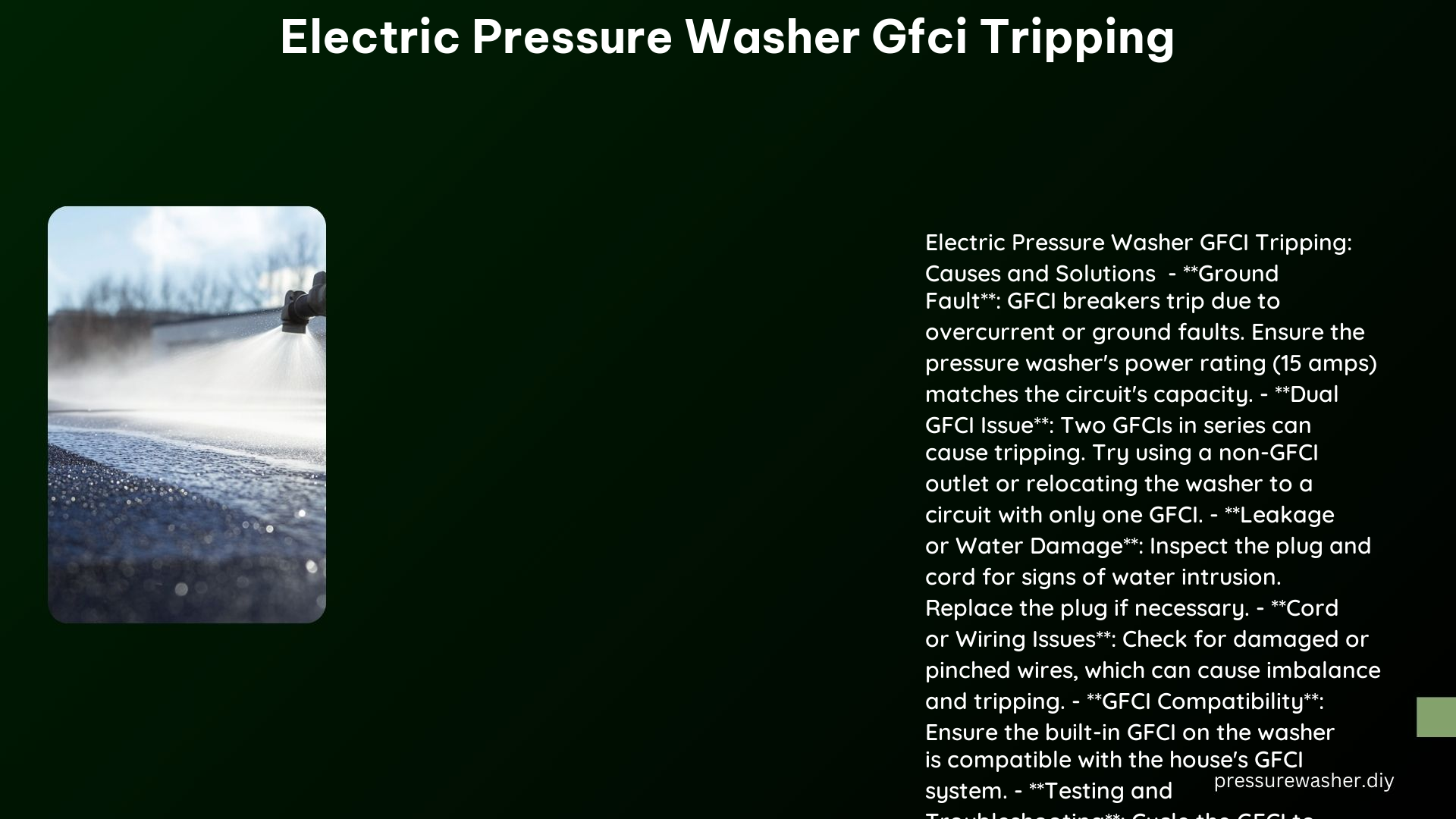Electric pressure washers are a powerful tool for cleaning various surfaces, but they can sometimes encounter an issue where the GFCI (Ground Fault Circuit Interrupter) trips, interrupting the power supply. This article delves into the common causes of GFCI tripping in electric pressure washers and provides comprehensive solutions to help you troubleshoot and resolve the problem.
Causes of GFCI Tripping
- Ground Leak:
- A ground leak occurs when there is an unintended path of electricity to the ground, which can be caused by water intrusion, damaged cords, or faulty internal components.
- This imbalance in current triggers the GFCI to trip, ensuring safety by preventing electrical shock.
- The GFCI detection circuit monitors the imbalance in currents between the hot and neutral wires. If an imbalance is detected, it trips to prevent electrical shock.
-
The typical threshold for a GFCI to trip is when the current imbalance exceeds 5 milliamperes (mA), which is well below the level that can cause harm to a human.
-
Overcurrent:
- If the pressure washer draws too much power for the circuit, it can cause the GFCI to trip.
- Ensure the circuit is rated for the pressure washer’s power requirements. Most electric pressure washers range from 1.5 to 2.5 horsepower (HP), which translates to a power draw of approximately 1,100 to 1,800 watts.
-
The circuit breaker and GFCI should be rated for at least 15 amps to handle the power requirements of a typical electric pressure washer.
-
Multiple GFCIs in Series:
- Having two GFCIs in series can cause them to trip due to interference between the devices.
- The GFCI detection circuit can be sensitive to the presence of other GFCIs, leading to nuisance tripping.
-
Try using the pressure washer on a circuit with only one GFCI to see if this resolves the issue.
-
Faulty GFCI:
- A malfunctioning GFCI can trip unnecessarily, indicating a need for replacement.
- The GFCI may have reached the end of its lifespan or been damaged due to environmental factors, such as moisture or physical impact.
- Test the GFCI by pressing the “Test” button, which should cause the “Reset” button to pop out, indicating the GFCI is functioning correctly. If the GFCI fails to trip, it may need to be replaced.
Troubleshooting and Solutions
- Check the Cord and Plug:
- Inspect the power cord and plug for signs of water damage or wear, such as cracks, cuts, or fraying.
- Replace the cord if any damage is found, as this can contribute to a ground leak and GFCI tripping.
-
Ensure the plug is fully inserted into the GFCI outlet and that the connection is secure.
-
Test the GFCI:
- Cycle the GFCI by pressing the “Reset” and “Test” buttons to ensure it is functioning correctly.
- If the GFCI fails to trip when the “Test” button is pressed, it may need to be replaced.
-
Consider testing the GFCI with a dedicated GFCI tester to verify its operation.
-
Use a Non-GFCI Outlet:
- If the pressure washer works on a non-GFCI outlet, it may indicate a problem with the GFCI or the circuit.
-
This can help isolate the issue and determine if the GFCI is the root cause of the tripping.
-
Consult the User Manual:
- Refer to the pressure washer’s user manual for specific troubleshooting and maintenance guidelines.
-
The manufacturer may provide additional guidance on GFCI-related issues and recommended solutions.
-
Upgrade to a Dedicated Circuit:
- If the pressure washer continues to trip the GFCI, consider installing a dedicated circuit for the pressure washer.
-
This will ensure the circuit is properly sized and isolated from other electrical loads, reducing the likelihood of GFCI tripping.
-
Replace the GFCI:
- If the GFCI continues to trip despite troubleshooting efforts, it may be necessary to replace the GFCI outlet or circuit breaker.
- Ensure the replacement GFCI is rated for the appropriate amperage and voltage to handle the pressure washer’s power requirements.
By following these troubleshooting steps and solutions, you can effectively address the issue of GFCI tripping in your electric pressure washer and restore reliable operation.
Technical Specifications
- GFCI Detection Circuit: The GFCI detection circuit monitors the imbalance in currents between the hot and neutral wires. If an imbalance is detected, it trips to prevent electrical shock.
- 2-Wire vs 3-Wire Cords: The main difference is the presence of a ground wire in 3-wire cords, which provides additional safety by detecting ground faults. 2-wire cords rely solely on the GFCI for ground fault protection.
- Typical Power Requirements: Most electric pressure washers range from 1.5 to 2.5 horsepower (HP), which translates to a power draw of approximately 1,100 to 1,800 watts. The circuit breaker and GFCI should be rated for at least 15 amps to handle the power requirements.
- GFCI Tripping Threshold: The typical threshold for a GFCI to trip is when the current imbalance exceeds 5 milliamperes (mA), which is well below the level that can cause harm to a human.
References
- Kranzle USA. (2023, April 27). GFI tripping vs fail | Kranzle USA Pressure Washer Perfection. YouTube. https://www.youtube.com/watch?v=XkSUCTfF4C4
- Physics Forums. (2017, October 9). Why is my power washer’s GFCI plug tripping and getting hot? https://www.physicsforums.com/threads/why-is-my-power-washers-gfci-plug-tripping-and-getting-hot.927947/
- Reddit. (2020, July 20). New Pressure Washer with GFCI power cord is tripping my home’s GFCI circuits. https://www.reddit.com/r/electrical/comments/huctwb/new_pressure_washer_with_gfci_power_cord_is/

